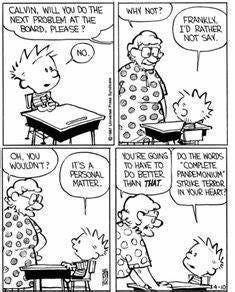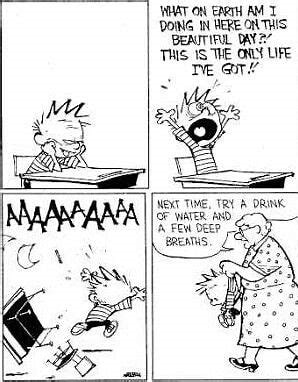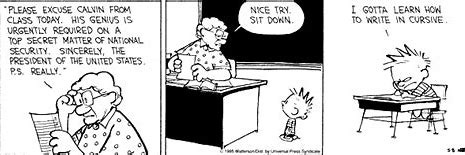What’s Inside?
Classroom Discipline: Start As You Mean To Go On
Start As You Mean To Go On
I remember as a new teacher working in a Christian school outside of Washington, D.C., a few days into my first full-time job as a high school history teacher, trembling inside while trying to keep my composure because my teenage students were misbehaving in class and wondering if I was going to do anything about it. I turned my back to the class and wrote something on the board in order to hide my distress. Inside I was praying desperately, “Oh God, help me! Help me! Help me know what to do!” The Lord, always faithful, gave me wisdom, and I decided to keep my mouth shut until I had time to pray and to seek counsel. They were going to act up again, thinking they had gotten away with it this time, but by then, I would be prepared to meet their challenge. How quickly things changed from a few days before, when everything was working out so beautifully in my mind.
Every new school year excites teachers, first years or veterans, as we ponder the possibilities of new beginnings. We dream of all the things we want to teach our students and the wonderful conversations we will have with them inside and outside of class, the ball games, the plays, the teacher appreciation week notes and gifts, Thanksgiving, Christmas, and Spring breaks;) As we join our colleagues for in-service meetings and we all prepare to enter bravely into the trenches again with renewed spirits and the vigor that summer break generates, as we meet the parents and students in casual meet and greets days before school officially commences, swept up in a rush of anticipation and excitement, we cannot image anything that could possibly spoil such an enchanting atmosphere. The first two days of classes go smashingly, and we think how wonderful and delightful it is to be a teacher!
Then . . . on the third day . . . things take a demonstrable turn toward darkness.
We feel the ebullient spirit of the new school year start to drift away, because the young people sitting in our classrooms do not quite share our joy. They are tired from having to wake up earlier than they did all summer. They cannot wear their favorite t-shirt and flip flops, because they have to wear a uniform with specified socks and shoes and ties and shirts. On the first day of class, they heard their teachers speak of self-government, respecting all class members, being responsible by having their supplies for class, but they were really imagining getting home and trying to eke out the last vestiges of summer before the real schoolwork began. So as the students begin to feel comfortable with their new teachers, and because they did not pay attention to most of the information conveyed the first day of class except when lunch and recess occurred, on the third day of school, without fail, the benign students of the first two days begin to act as though they are back home during summer break. They start acting relaxed and free to behave any way they want. As they quickly move back into summer habits, there is a point where they do realize they are not following expectations for classroom behavior, and at this point of realization, some students make the decision to see how much they can get away with. How far can they go with their shenanigans before their new teacher, maybe brand new to teaching or a veteran, but new to them, is going to stop their barely disobedient, barely distracting, and only just a little out of line behavior? They wonder how many looks and/or verbal warnings they will receive before they are asked to stay after class or given a demerit. They then deliberately push the boundaries to find out exactly how far they can push their teacher before any real consequences develop. Some students will literally count how many times they can misbehave before they get into any kind of trouble from the teacher and purposefully misbehave that many times in each class. Lest anyone doubt me, I have many a confession from many a student on this score.
Once the disobedience, disrespect, or general shenanigans begin, the teacher’s next decision determines how the rest of the year will progress. The ebullient spirit that emanated from everyone during in-service, meet and greets, and the first two days of class cannot be captured in its entirety again, after all, we are no longer just coming off summer break, but a teacher who thinks wisely and purposefully about classroom discipline can contain a reasonable portion of that cheerfulness for the class and all can enjoy a delightful school year. All he/she has to decide is this: “What will the next two months look like for me and my classes? Am I going to drop the hammer deliberately and stop the shenanigans, knowing that I will endure the wrath of disgruntled youth who must learn to govern themselves and to respect the boundaries I have set for them, or am I going to fear my students’ wrath and choose to appease them for the sake of classroom harmony?”
The teacher may have read articles and books using ambiguous language listing ways to create a positive classroom environment, possibly not noticing that these books tend to avoid writing in clear language what really needs to be done to accomplish such a goal, so the correct answer must be to get along with the students as best as possible while avoiding anything that might cause controversy, correct? Only if you want to live, and allow your students to live, in chaos for the next nine months . . . If you want to have classroom harmony for the entire school year, the next two months are crucial; they might be unpleasant and in some schools, downright hard, but if you persevere, you will have a harmonious classroom where students feel free to inquire and wonder, where respectful discussions are held, and where the students learn academic knowledge and develop virtue.
For the next two months, you need to firmly, calmly, and kindly, stop the disobedience, the disrespectful actions, and the shenanigans of children still trying to act out summer break if you are going to create a classroom atmosphere that is calm, ordered, and safe for inquiry. The first two months is when the fiercest testing occurs. Once you think you have one situation handled, other students emerge who try their own hands at being ungoverned in order to take the place of those who just learned to govern themselves. Sometimes, it feels like you are playing a game of Whack-a Mole – one problem gets sorted and another comes up. You feel conflicted inside, because you want to have a good relationship with all of your students, but for a little while, you have to have talks with students and their parents and dole out discipline. You endure the uncomfortable period, because you know that classroom harmony can only come when your students govern themselves and respect the boundaries you have set for them.
In my experience working with students in private Christian and Classical charter schools, it usually takes two months for all of the students in the class to learn to govern themselves and respect the boundaries set for them. Once the two months’ is over, once the students have learned to govern themselves and anxious parents are on board, the rest of the school year is a joyful experience for teacher and students alike. Keep in mind that the students who want to learn are extremely appreciative of the teacher’s actions to create an ordered classroom, but they do not usually let you know this at the time. By January, a look, a point, a reminder that those who govern themselves do not have to be governed by others is all that is needed to keep the class humming along peacefully. Once the testing period is over, the most wonderful teacher-student relationships develop, students learn to love learning, and coming to school each day is a pleasure for everyone.
A teacher who does not choose the first two months to establish boundaries and insist that students learn to be self-governing will create a classroom atmosphere of uncertainty, disorder, and frustration. The class will have many students who want to learn, but they are prevented from learning by the distracting misbehavior of students who are not governing themselves and a teacher afraid to establish strong boundaries.
For example, I taught outdoor education a couple of years at a camp where we had fifteen fifth-graders for three hour classes held outside. A few times of year, we got a group of students in who behaved and followed directions immediately. We always finished those classes an hour early even though we did everything the same as in the other classes that lasted three hours. We realized that we spent an hour out of the regular three hour classes redirecting students who were not following directions, misbehaving, etc. Can you imagine the time lost to instruction in a chaotic classroom over the course of a school year?
Back to my point, by the spring, even the teachers who tried to get along and be friends with their students are fed up with the shenanigans. They often begin to yell at the students to behave and dole out their punishments in anger. Some give up trying to maintain order and teaching in their classes becomes almost non-existent.
During the spring of my first year teaching high school, the admissions director started coming into my room frequently with parents and prospective students taking a peek at what classes looked like in the school. I did not think anything about it and figured that was commonplace for all the other teachers as well. At the end of the year, the admissions director came up to me and thanked me for letting her open my door so much. I was surprised at her gratitude and it showed on my face, because she responded, “Yours was the only classroom where I knew if I opened the door, you and your students would be working calmly and orderly.” I had not beaten my students into submission, that would have been impossible. I had set boundaries and established a protocol for students to govern themselves. Throughout the year, I had figured out how to enforce the boundaries, expectations, protocols, etc., through after class conversations with students, conversations with parents, handing out lunch detentions and after school detentions, asking coaches for their support, who gave it gladly for tutoring in return, and I had been consistent. It was hard work and it took a lot of my time at first. One day during the testing period, my principal told me that my students had complained about me. They said that I made them work and behave, but that I was fair. I took that as a compliment and so did he;)
It is natural for a new teacher to wonder, “Won’t my students hate me if I make them work and behave so early in the school year. Shouldn’t I ease my students into working hard and self-governance?” Hate is a strong word, but dislike is appropriate, and my answer is “Yes, initially, they will dislike you. Secondly, there is no easing in where there is a conflict of wills. The conflict has to happen at some point, so why not sooner than later?” You will get a lot more done and have a much better time as a teacher when you nip things in the bud. The students will begin learning well, earlier.
The interesting thing about children is that they recognize love in its different forms and they learn to recognize the love their teacher has for them when he/she establishes strong boundaries and firm discipline and shows compassion and grace when the situation calls for it.
I had one student who used to smile at me while I was actually correcting her. It was unsettling. I realized later that she was saying, “Thank you” in her funny way. I would speak plainly and truthfully to her and she told me that when she told her mother what I had said, her mother wholeheartedly agreed. When she had a detention with me, which occurred a few times that first year, she would smile sincerely as she left and wish me a good day.
That strange phenomenon still goes on today. The only thing I can think of to account for students thanking me for after school detention is that they know, deep down, that I love them. If I did not care about them, I would leave them to do whatever they thought was right in their own eyes. I imagine this scenario plays out all over the country with students who know their teachers love them with Christ’s love. It is difficult to love someone you do not know well, unless you love them with the love God gives you. Ask the Lord for that love everyday!
Remember that Webster’s 1828 Dictionary definition of discipline, “education; instruction; comprehending instruction in arts, sciences, correct sentiments, morals and manners, to prepare by instructing in correct principles, habits, and due subordination to authority,” requires a Classical teacher to lead their students in developing correct sentiments, morals, manners, habits, principles, and due subordination to authority. How do you do this if you do not purposely engage the flawed human nature of your students with the love that God gives us for His children? Have a plan in place before that third day comes, knowing that by following the Lord’s framework for disciplining children, the other work you have to complete, the work of instruction in arts and sciences, will be as successful in training your students academically as your discipline is in training your students in virtue.
Start as you mean to go on.
**What direction does the Lord give us in disciplining children? Read my next newsletter.








